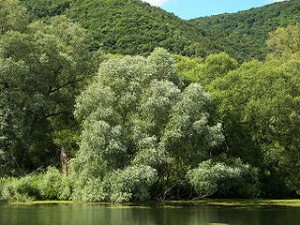Hecate and the Waterway
Throughout most of human history, the primary method of travel was via water rather than road. Even in the Ice Age, settlement patterns and artifacts reflect reliance on river trade, sometimes over long distances. Considering the primacy of early water travel, it is not surprising that the route to the afterlife is via river in many cultures.Water is also linked with birth as well as death, since the fetus grows in a sack of liquid which opens at birth. The moist birth canal can be compared to a small waterway. Water nourishes all animal and plant life. Water is the most basic and important substance of healing.Water has a special relationship with the moon. The full moon’s influence on the tides is the most obvious, but the moon has a subtle effect on other waterways, including the waters of the womb. While scientists scoff, midwives and others involved in obstetric care firmly believe the full moon is capable of inducing labor. “As the moon empties, so does the womb.” The moon’s reflection on slow-moving rivers and pools of fresh water magically charges the water with the moon’s life-giving energies.In the northern hemisphere the most ubiquitous tree along rivers is the willow. This tree produces a strong yet pliable bark that is useful for basket weaving. The birch twigs of the witch’s broom are traditionally latched to the ash handle with strips of willow bark. Dowsers generally use willow (or hazel) twigs for divining underground water sources. The willow is certainly in the top five preferred trees for magic wands, partly because it grows along riverbanks and is thus nurtured with water charged by the moon.The willow is one of the first trees to reawaken in early spring, and the fibrous blossoms (called catkins) have in bygone eras provided nourishment during this hungry time. Bees also feast on catkins as they emerge from their hives. The most important contribution of willow to humankind, however, is as a medicine. The bark of the willow tree contains an important pain relieving anti-inflammatory substance from which aspirin was originally derived. While aspirin, both synthetic and derivative, is a relatively new arrival, the use of willow bark is documented in early medical texts.The white willow tree (Salix alba), which produces the preferred bark for pain relief, is native to Europe and western Asia. It is called a “white” willow because the underside of the leaf is covered with silky white down that gives the tree a silvery appearance. This is the tree sacred to the goddess Hecate. She is a goddess associated in classical times with death and travel, and her followers at that time were primarily healers and primarily women. It was once common for Hecate shrines and offerings to be located along roads or at crossroads. As goddess of death she became linked with the dog, while as goddess of the road she became linked with the horse, but Hecate’s worship predates the domestication of both the dog and the horse. I believe she was originally worshiped as Queen of the Waterways in the form of the willow tree. This is how she received her association with healing and with the moon. Her association with death relates to the dark waters flowing quietly back to the source.Hecate is sometimes called a “crone goddess,” but despite her death aspect she appears as a youthful woman, reminiscent of the pliant willow which alleviates the effects of time on the body. She has dark hair, large black eyes, and luminous white skin. Like her tree she has a large, beautiful and unassuming grace.
SourcesMonaghan, Patricia. The Book of Goddesses and Heroines. St. Paul, MN: Llewellyn, 1990.Plants for a Future. Salix alba.
SourcesMonaghan, Patricia. The Book of Goddesses and Heroines. St. Paul, MN: Llewellyn, 1990.Plants for a Future. Salix alba.


